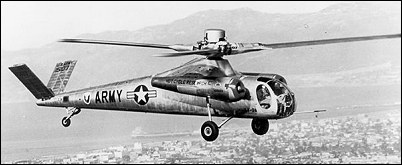
| Hughes Model 385 / XV-9A "Hot Cycle" 1947 |  |
 |

| Hughes Model 385 / XV-9A "Hot Cycle" 1947 |  |
 |
|
Convinced that the use of gas pressure to drive rotors, as used in the XH-17 and proposed for the XH-28, was superior to conventional methods as the elimination of the transmission drive system resulted in a lighter, less complex, and more easily maintained system, Hughes engineers sought ways to improve the propulsive efficiency of pressure-jet rotors. Eventually concluding that much improvement would result from ducting the hot efflux of gas generators directly to cascade vanes at each blade-tip instead of piping cold air to tip-burning nozzles, they succeeded in attracting the interest of the US Army. Funded by the Army beginning in 1962, the multi-phase development programme for the Model 385 began with 60 hours of test running of a prototype hot-cycle rotor mounted on a ground rig. As results were encouraging, Hughes proceeded to the next phase, 15 hours of bench testing of the Model 385 propulsion module consisting of two General Electric YT64-GE-6 gas generators mounted at the tips of stub wings and driving a three-bladed rotor. Each blade was of two-spar construction with the hot efflux of the gas generators being taken to vanes at their tips by means of a Rene 41 high-temperature steel duct passing between the spars. Cooling air was forced through the leading and trailing edges of the constant-chord blades and was exhausted at the tip, fore and aft of the hot efflux. Results remaining promising, Hughes was authorized to proceed with the manufacture and testing of a research vehicle, the XV-9A (serial 64-15107), which was given a VTOL mission designator instead of the more traditional H helicopter designator. As the XV-9A was only intended as a demonstrator for the hot-cycle system, the Army requested that manufacturing costs be kept to a minimum by using components from other aircraft. Thus, the cockpit of a Hughes OH-6A (with side-by-side accommodation for a pilot and a co-pilot/flight test engineer) and the undercarriage of a Sikorsky H-34 were mated to a specially-built fuselage and V-tail. The hot efflux from two General Electric YT64-GE-6 gas generators, which were loaned by the Navy and mounted at the tips of a stub wing, drove the three-bladed rotor. Bleed air from these generators was ducted to a yaw control system at the tail. First flown by Robert G. Ferry at Culver City on 5 November, 1964, the XV-9A remained at the manufacturer's facility until it had completed an initial 15-hour flight test programme. It was then transferred to Edwards AFB, where an additional 23 hours were flown. From an engineering point of view, tests proved highly satisfactory and in 1965 Hughes confidently predicted that the hot-cycle system would be used for heavy-lift military helicopters and for compound civil helicopters. The latter, which were to have been fitted with short wings and forward thrust fans, were expected to fly at speeds of up to 480km/h. From the environmental and economic points of view, however, the XV-9A was less successful as the exhaust of hot efflux through cascade vanes at the tips of the rotor was noisy and unacceptable in urban areas and as fuel consumption rate was high. To mitigate these deficiencies, Hughes proposed a refinement of the pressure-jet concept based on the use of turbofans in lieu of gas generators. This warm-cycle system was tested in a wind tunnel and on a whirling stand but improvements were insufficient to warrant the manufacture and testing of a flying prototype, thus bringing to an end the development by Hughes of pressure-jet systems successively based on the cold-cycle principle, as used for the XH-17 and XH-28, the hot-cycle principle, as featured by the XV-9A, and the warm-cycle principle, as evaluated during whirling stand tests. Rene J. Francillon "McDonnell Douglas Aircraft since 1920: Volume II", 1997
This was a large experimental heli-copter built in 1964 to study blade-tip nozzle jet propulsion. Some of the parts were taken from existing aircraft. The version for the US Army was designated XV-9A and had a three-blade constant chord metal rotor. There was room for two pilots seated side by side in the cockpit. G.Apostolo "The Illustrated Encyclopedia of Helicopters", 1984 In 1962 Hughes Helicopters was awarded an Army contract for the development and construction of a research helicopter utilizing a hot-cycle propulsion system. The resulting XV-9A (serial 64-15107) made its first flight in November 1964. Though rather ungainly-looking the XV-9A was of essentially straightforward construction. Indeed, in order to save time and money in the building of what was certain to be the only vehicle of its type Hughes' engineers assembled the XV-9A using the cockpit of an OH-6A, the landing gear of a Sikorsky H-34, and a simple purpose-built cylindrical fuselage with a twin-rudder V-tail. It was, in fact, the XV-9A's experimental propulsion system that made the otherwise mundane craft unique. The system was built around two pod-mounted General Electric YT64-GE-6 engines fitted to the ends of two high-set stub wings, one on either side of the fuselage directly below the main rotor hub. Each engine's turbine section had been removed, and hot exhaust gases were ducted directly through the rotor hub to be expelled at near-sonic speeds through vaned cascades in each of the three blade tips. Smaller exhaust ports on either side of the tail boom just forward of the rudders provided some additional directional stability. The XV-9A's flight test programme was completed in August 1965, with a total of 19.1 hours having been flown. The hot-cycle propulsion system had proved to be overly complex and the aircraft itself had been plagued by stability problems; the Army therefore returned ownership of the XV-9A to Hughes and abandoned any further hot-cycle research. S.Harding "U.S.Army Aircraft since 1947", 1990 * * *
|